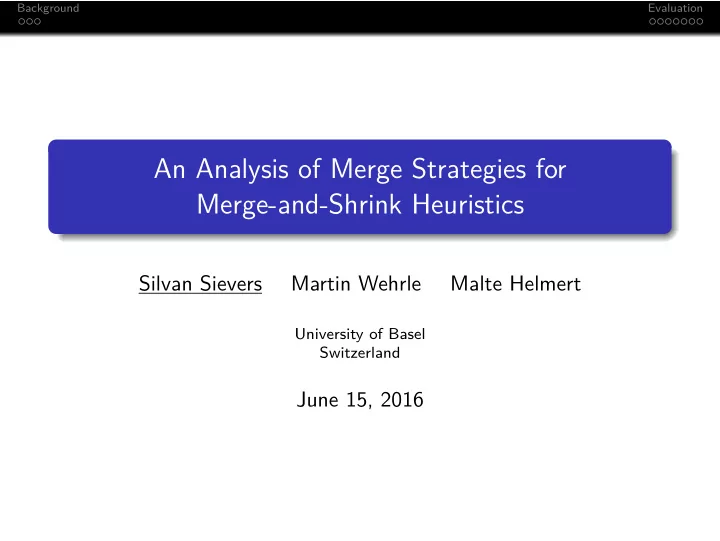

Background Evaluation An Analysis of Merge Strategies for Merge-and-Shrink Heuristics Silvan Sievers Martin Wehrle Malte Helmert University of Basel Switzerland June 15, 2016
Background Evaluation Outline Background 1 Evaluation 2 All Merge Strategies Random Merge Strategies DFP A New Strategy
Background Evaluation Setting Classical planning as heuristic search Merge-and-shrink: abstraction heuristic
Background Evaluation Merge Strategy Binary tree over state variables v 5 v 4 v 1 v 4 v 5 v 3 v 2 v 3 v 1 v 2
Background Evaluation Motivation Recent development allows (efficient) non-linear merge strategies Presumably (and theoretically) large potential for better merge strategies Only little research on merge strategies
Background Evaluation Outline Background 1 Evaluation 2 All Merge Strategies Random Merge Strategies DFP A New Strategy
Background Evaluation All Merge Strategies – Zenotravel #5 % of strategies with ≤ expansions 100 80 ALL 60 0 50 100 150 200 250 expansions until last f -layer
Background Evaluation All Merge Strategies – Zenotravel #5 % of strategies with ≤ expansions 100 80 ALL CGGL/MIASM/ MIASM-SYMM DFP/RL/ CGGL-SYMM/ DFP-SYMM/ 60 L-SYMM/ RL-SYMM L 0 50 100 150 200 250 expansions until last f -layer
Background Evaluation Random Merge Strategies Sample of 1000 random merge strategies per task on the entire benchmark set
Background Evaluation Random Merge Strategies Sample of 1000 random merge strategies per task on the entire benchmark set Expected coverage: 680 . 17 (baseline: 710 – 757) 72 tasks in 19 domains solved by strategies from the literature, but no random one
Background Evaluation Random Merge Strategies Sample of 1000 random merge strategies per task on the entire benchmark set Expected coverage: 680 . 17 (baseline: 710 – 757) 72 tasks in 19 domains solved by strategies from the literature, but no random one 21 tasks in 9 domains solved by at least one random strategy, but none from the literature
Background Evaluation Random Merge Strategies – NoMystery-2011 #9 30 % of strategies with ≤ expansions RND (278/1000) 20 10 0 10 4 10 5 10 6 10 7 uns. expansions until last f -layer
Background Evaluation Random Merge Strategies – NoMystery-2011 #9 30 % of strategies with ≤ expansions RND (278/1000) CGGL/ MIASM MIASM-SYMM 20 CGGL-SYMM DFP/RL RL-SYMM DFP-SYMM L/L-SYMM/ 10 RND (722/1000) 0 10 4 10 5 10 6 10 7 uns. expansions until last f -layer
Background Evaluation DFP Score-based merge strategy: prefer transition systems with common labels synchronizing close to abstract goal states Problem: many merge candidates with equal scores
Background Evaluation DFP Score-based merge strategy: prefer transition systems with common labels synchronizing close to abstract goal states Problem: many merge candidates with equal scores Use tie-breaking: Prefer atomic or composite transition systems Additionally: variable order (L or RL or RND) Alternatively: fully randomized
Background Evaluation DFP – Results Prefer atomic Prefer composite Ran- RL L RND RL L RND dom Coverage 726 760 723 745 729 697 706 Linear (%) 10.8 10.9 10.6 81.7 86.5 84.3 13.2 Performance (coverage) strongly susceptible to tie-breaking Strategies ranging from mostly linear to mostly non-linear
Background Evaluation A New Strategy Based on the causal graph (CG) Compute SCCs of the CG Use DFP for merging within and between SCCs Mixture of precomputed and score-based strategies
Background Evaluation A New Strategy (SCC-DFP) – Results Prefer atomic Prefer composite Ran- RL L RND RL L RND dom Coverage 751 760 732 776 751 741 736 (+25) (+0) (+9) (+31) (+22) (+44) (+30) Linear (%) 8.2 8.4 8.2 58.2 58.7 61.6 11.5 (-2.6) (-2.5) (-2.4) (-23.5) (-27.9) (-23.2) (-1.7) Complementary to MIASM
Background Evaluation Conclusions Random merge strategies show the potential for devising better merge strategies DFP strongly susceptible to tie-breaking New state-of-the-art non-linear merge-strategy More details: paper or poster
Background Evaluation Appendix – MIASM Precomputed (sampling-based) merge strategy which aims at “maximizing pruning”: partitioning of state variables based on searching the space of variable subsets
Background Evaluation Appendix – MIASM Precomputed (sampling-based) merge strategy which aims at “maximizing pruning”: partitioning of state variables based on searching the space of variable subsets Simpler score-based variant: Compute all potential merges Choose the one allowing the highest amount of pruning
Background Evaluation Appendix – MIASM Precomputed (sampling-based) merge strategy which aims at “maximizing pruning”: partitioning of state variables based on searching the space of variable subsets Simpler score-based variant: Compute all potential merges Choose the one allowing the highest amount of pruning Performance not far from original MIASM (best coverage: 747)
Background Evaluation Appendix – Score Based MIASM Prefer atomic Prefer composite Ran- RL L RND RL L RND dom Coverage 743 746 745 747 724 730 726 Linear (%) 10.4 10.5 11.9 45.2 53.2 51.2 11.8
Recommend
More recommend